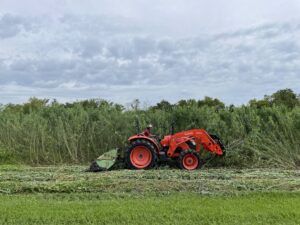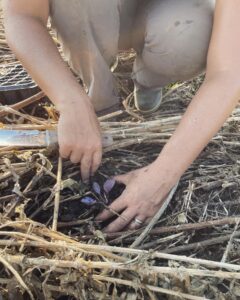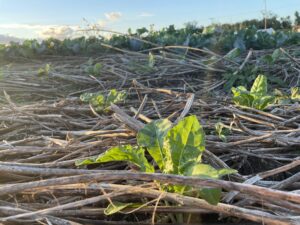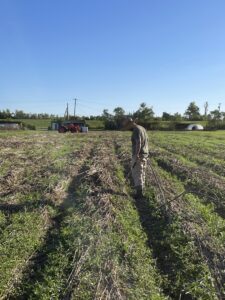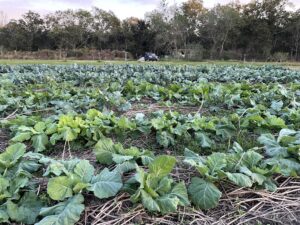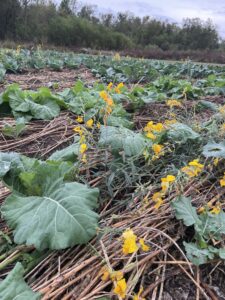Project Overview
Commodities
- Agronomic: sunn hemp
Practices
- Crop Production: cover crops
- Pest Management: mulches - general
Proposal summary:
We believe that sunn hemp seeded with a no-till drill for optimal coverage and crimped at the right height has the potential to reduce reliance on tillage and create a growing environment that would enable year-round vegetable production on our farm.
In May of this year, we started an experiment in one of our fields that had been cover cropped for nine months following Hurricane Ida. We seeded approximately an acre with sunn hemp and let it grow all summer long. In early September when the sunn hemp was well over 10’ tall, we crimped it with a roller crimper that we’d purchased the previous year. (See photo 1.) This created a mass of material that we then directly planted our fall brassicas into. (See photos 2 and 3.) The crimped sunn hemp is acting as an in-place mulch for weed suppression in long season crops. Although the timing of the crimping and the coverage of the sunn hemp wasn’t ideal (photo 4 shows moderate presence of weeds), this experiment showed promising results for addressing some of the concerns described above. (See photos 5 and 6 for current conditions after intensive hand-weeding.)
If we were to seed and crimp earlier, we believe that we could plant long season summer-to-fall crops into the crimped sunn hemp, which would suppress weeds during the weediest time of year. It would replace the need for black plastic or herbicides, providing a viable alternative for sustainable summertime growing in our region. We would not need to till or disc, as we currently do any time we turn over cover crop to plant a new crop, and the sunn hemp generates a massive amount of material that replenishes carbon and fixes nitrogen. The presence of this voluminous ground cover also enables us to access the fields with a tractor, even during the wet summer season, when we otherwise would not be able to drive heavy equipment over bare, muddy soil.
From an economic standpoint, we believe using sunn hemp as a grown-in-place mulch for summer crops would increase our crop yield during the slow market period during September and early October. Crops like winter squash, melons, and fall peppers, which we currently don’t grow at all because of the challenges of over-summering in our climate, would enable us to return to market a month earlier than we currently do. It would have a positive impact on the market, which is typically low on products across the board that time of year, and it would mean that paying our employees during the summer and early fall would have a quicker pay-off. With a successfully applied sunn hemp crop, these summer edible crops would be low maintenance for an employee to manage during the hottest, wettest months.
In addition to the photos, please also see attached letters of support from our collaborators and other relevant community partners.
Letter of Support - Angelina Harrison, Crescent City Farmers Market
Letter of Support - Anna Timmerman, LSU Ag Extension Agent
Project objectives from proposal:
Proposed Strategy:
Use of sunn hemp as weed suppression and technique for reducing tillage to allow marketable summer crop production and no/low tillage field prep year-round.
Methodology:
We intend to introduce regular sunn hemp seeding with a no-till drill into our crop rotation to be roller crimped and used as a mulch for year-round vegetable production. Sunn hemp seeded with a no-till drill would reduce the dependance on tillage, allowing us to seed directly into existing raised beds directly following the termination of previous crops. This system will improve our ability to grow marketable crops during the environmentally challenging summer season. It will also improve and maintain soil health through:
- Regular cover cropping and use of mulching to add nutrients (carbon, nitrogen).
- Weed control through regular cover cropping with rapid growing sunn hemp seeded with no-till drill, and the subsequent presence of sunn hemp residue as mulch post-roller crimping.
- Use of frequent cover cropping to maintain soil structure through repeated plantings directly into mulch without requiring tillage.
To determine the effectiveness of this solution, we would collect data on the following measures:
1.Improvement of nutritional levels in soil.
- Soil sample annually to reveal changes to nutrient levels. Note that Field B has had prior sunn hemp crop.
2.Effectiveness of weed control.
- Keep data on frequency of hand weeding. (Compare to current crop).
- Regular observation and comparison of weed pressure to other fields where sunn hemp has not been applied. This will be accomplished through comparing photos and taking observational notes.
3.Reduction in need for tillage.
- Keep data on frequency of tillage (discing).
- Use drone images to track sunn hemp seasonal growth and measure coverage with no-till drill. Can be compared year-to-year.
4.Reduced amount of time away from market.
- Keep data on volume and viability of new crops that we haven’t grown before including winter squash, melons, fall peppers.
- Compare market return dates to previous years.
- Compare revenue generated in September and October to past years.
By implementing a system of crop rotation with sunn hemp on three separate fields (B, E, and H) through the two year duration of this project, we will be able to observe the four different seasons of a three-year rotation using sunn hemp, edible crops, and other cover crops. By using three different fields totalling approximately 1.5 acres, we will be able to compare soil samples at different stages and maximize the limited window of the project to collect the most data.
